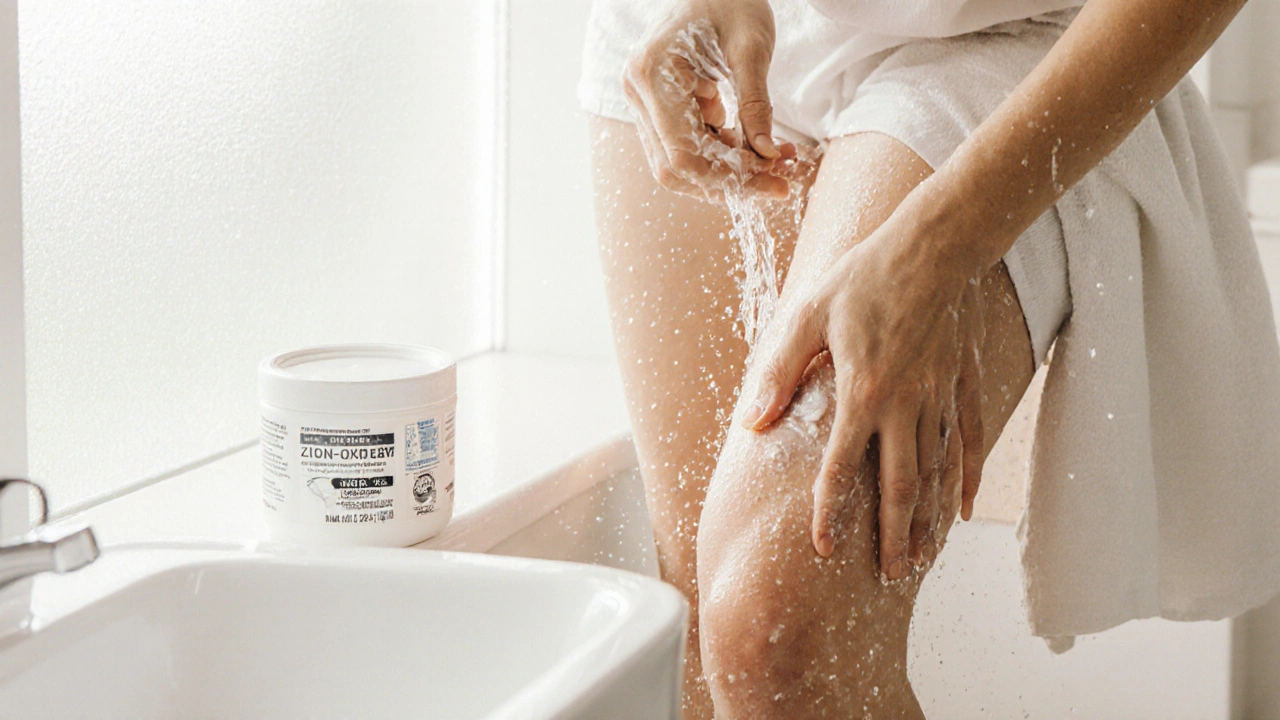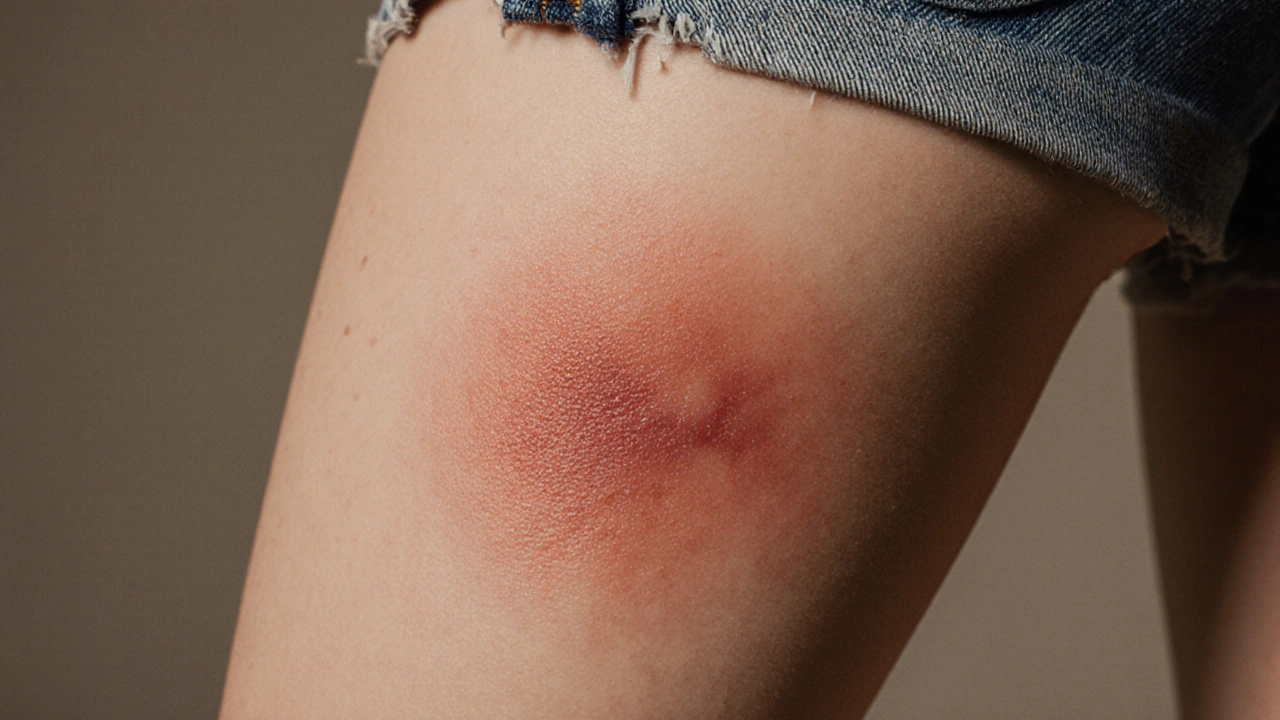Skin Chafe Treatment Selector
Recommended Treatment Plan
Barrier Ointment
Petrolatum or Zinc Oxide
Creates waterproof shield
Moisturizing Cream
Shea butter, Glycerin
Hydrates skin
Hydrocortisone 1%
Hydrocortisone
Reduces inflammation
Aloe Vera Gel
Aloe vera extract
Soothes burn-like pain
When a pair of jeans or a bra digs into you, the resulting Skin chafe is a painful irritation caused by friction against the skin, often from tight or rough clothing. It feels like a red, raw patch that can itch, burn, or even ooze if left unchecked. This guide shows you how to calm the burn, speed up healing, and stop the cycle of irritation.
Quick Takeaways
- Clean the area gently with lukewarm water and a mild cleanser.
- Apply a barrier ointment (zinc oxide or petrolatum) right after cleaning.
- For inflammation, a 1% hydrocortisone cream works best for short‑term use.
- Switch to soft, breathable fabrics and consider seamless or loose‑fit alternatives.
- Seek medical advice if the rash spreads, blisters, or shows signs of infection.
Why Ill‑Fitting Clothing Causes Chafe
Two forces drive the problem: friction and moisture buildup. Tight seams or rough seams rub repeatedly, breaking the skin’s outer barrier. Sweat and water then trap heat, making the skin softer and more vulnerable. Over time, the combination creates a classic irritant dermatitis - the medical term for a rash caused by an external irritant.
Spotting the Signs
Typical symptoms include:
- Red or pink patches where clothing seams sit.
- A burning or itching sensation that worsens with movement.
- Small blisters or weeping sores if the friction is severe.
If you notice swelling, pus, or a fever, it’s time to see a professional.

Immediate Relief Steps
- Gently wash the affected area with lukewarm water and a fragrance‑free cleanser. Avoid scrubbing - you want to remove sweat and debris, not aggravate the skin.
- Pat dry with a clean, soft towel. Do not rub.
- Apply a thin layer of a barrier ointment such as zinc oxide or plain petrolatum. This creates a protective film that reduces further friction.
- Wear loose, breathable fabrics (cotton, modal, bamboo) over the treated spot. Seamless underwear can be a game‑changer.
Choosing the Right Treatment
Below is a quick comparison of the most common over‑the‑counter options. Pick the one that matches your symptom severity and skin type.
| Treatment Option | Active Ingredient | Pros | Cons |
|---|---|---|---|
| Barrier Ointment | Petrolatum or zinc oxide | Creates a waterproof shield; minimal irritation risk | Can feel greasy; may stain dark clothing |
| Moisturizing Cream | Shea butter, glycerin | Hydrates skin; pleasant scent | Less protective against friction |
| Hydrocortisone 1% Cream | Hydrocortisone | Reduces inflammation quickly | Not for prolonged use; may thin skin |
| Aloe Vera Gel | Aloe vera extract | Soothes burn‑like pain; cooling effect | Limited barrier protection |
For everyday chafe, a barrier ointment is the safest first line. If you notice swelling or intense redness, add a short course (no more than 5‑7 days) of hydrocortisone.
Long‑Term Prevention Tips
- Shop for cotton undergarments or other natural fibers that wick moisture away.
- Choose seamless designs for bras, socks, and sportswear.
- When you buy new clothing, try it on and move around; pay attention to any pressure points.
- Apply a thin layer of petroleum‑based ointment on high‑risk areas (inner thighs, under bra straps) before dressing.
- Use an anti‑chafing stick or powder during workouts or long walks.

When to Call a Healthcare Professional
If any of the following appear, don’t wait:
- Rapid spreading of redness beyond the original friction zone.
- Visible pus, yellow crusts, or foul odor - signs of infection.
- Severe pain that interferes with daily activities.
- Recurring chafe despite preventative measures; could indicate an underlying skin condition.
A clinician may prescribe a stronger steroid, oral antibiotics, or evaluate for allergic contact dermatitis.
Quick FAQ
Frequently Asked Questions
Can I use baby oil as a barrier?
Baby oil creates a temporary slip layer, but it can stain clothes and may not stay in place during heavy sweating. Petroleum‑based ointments are more reliable.
How long does a chafe patch take to heal?
Mild irritation usually resolves in 2‑4 days with proper care. Moderate cases can take up to a week. Persistent or infected lesions may need professional treatment.
Is it safe to apply hydrocortisone on compromised skin?
Yes, for short periods (5‑7 days) on non‑broken skin to reduce inflammation. Avoid using on open wounds or for longer than recommended, as it can thin the skin.
Do I need to stop wearing the offending clothing altogether?
If the item consistently causes friction, replace it with a better‑fitting alternative. Sometimes a minor adjustment, like a size up or a different seam placement, resolves the issue.
Can natural remedies like tea tree oil help?
Tea tree oil has antiseptic properties but can be irritating on broken skin. Dilute it heavily (1‑2 drops in a carrier oil) or stick to proven barrier ointments for first‑line care.


mathokozo mbuzi
October 6, 2025 AT 17:46While the guide covers the essential steps, it's also worthwhile to consider the role of environmental humidity; higher moisture can exacerbate friction, so keeping the skin dry with talc‑free powders may further reduce chafing. Additionally, rotating clothing materials-alternating between cotton and moisture‑wicking synthetics-can prevent the skin from becoming overly saturated.
Penny X
October 6, 2025 AT 19:59It is incumbent upon individuals to recognize that neglecting proper garment selection constitutes a disregard for one's own bodily integrity; therefore, proactive measures such as selecting seamless designs should be embraced as a moral responsibility to oneself.
Amy Aims
October 6, 2025 AT 22:13Great tips! 😊 Just remember to reapply that barrier ointment after a sweaty workout, and your skin will thank you. Keep it up! 🙌
Shaik Basha
October 7, 2025 AT 00:26lol yea, i always forget to dabbing that petroleum jelly before a long hike. it feels kinda greasy but hey, no more red patches!!
Michael Ieradi
October 7, 2025 AT 02:39It is advisable to maintain a consistent cleaning routine; gentle cleansing followed by a thin layer of zinc oxide creates a durable barrier-this simple protocol often prevents progression from mild irritation to more severe lesions.
Stephanie Zuidervliet
October 7, 2025 AT 04:53Seriously!!! Who even thinks they can wear those tight jeans all day without consequences??? Your skin will revolt!!!
Dawn Mich
October 7, 2025 AT 07:06Don't be fooled by big‑brand marketing that pushes synthetic fabrics as "high‑performance"-they're engineered to trap sweat and increase friction, effectively turning your clothes into a covert weapon against your skin.
Eric Sevigny
October 7, 2025 AT 09:19Actually, a decent altarnative is using a small amount of lanolin-it's not as greasy as petrolatum but still forms a protective film. Just be sure to patch test first, some folks can react.
Glenda Rosa
October 7, 2025 AT 11:33While the article touts barrier ointments as the holy grail, let's not overlook that over‑reliance on petroleum products can suffocate the skin's natural microbiome, leading to a cascade of unforeseen irritations-so a judicious balance is key.
charlise webster
October 7, 2025 AT 13:46Honestly, the best cure is simply buying better‑fitting clothes.
lata Kide
October 7, 2025 AT 15:59😂💡 But hey, if you must endure those pesky seams, a quick dab of baby oil (just a *tiny* amount) can act like a slip‑n‑slide for your skin-just don’t forget to wipe off the excess or you’ll look like a grease‑ball! 🕺
Mark Eddinger
October 7, 2025 AT 18:13For individuals with particularly sensitive skin, consider applying a hypoallergenic, fragrance‑free barrier cream containing dimethicone; this silicone‑based polymer provides a non‑occlusive shield while minimizing the risk of allergic reactions.
Francisco Garcia
October 7, 2025 AT 20:26It's also worth noting that cultural attire often incorporates design elements that reduce friction-think of traditional loose‑fitting garments like kimonos or dhotis. By studying these styles, we can adopt practical lessons for everyday wear, such as using elastic waistbands instead of rigid seams. Moreover, rotating your wardrobe to include these loose pieces can give your skin breathing room.
Patrick Renneker
October 7, 2025 AT 22:39In the realm of dermatological maintenance, the prophylactic application of occlusive agents occupies a position of paramount significance, particularly when one contemplates the myriad biomechanical forces exerted upon cutaneous surfaces by contemporary apparel. The first consideration, naturally, pertains to the physicochemical composition of the ointment itself; petrolatum, as an inert hydrocarbon matrix, offers unparalleled resistance to transepidermal water loss, thereby preserving the integrity of the stratum corneum. Secondly, one must evaluate the temporal dynamics of barrier formation, recognizing that a fully established film may require a latency period of several minutes post‑application before it attains optimal viscosity. Third, the interaction between the barrier and underlying epidermal lipids is of consequence, for an overly lipophilic layer may impede the diffusion of essential moisturizers. Fourth, the aesthetic ramifications-such as the propensity for staining dark fabrics-cannot be dismissed, especially for individuals whose attire is predominantly of a darker hue. Fifth, the potential for comedogenicity, albeit minimal with pure petroleum jelly, should be monitored in patients predisposed to acneiform eruptions. Sixth, the environmental considerations of petroleum‑based products invoke a broader discourse on sustainability, urging practitioners to weigh ecological footprints against clinical efficacy. Seventh, the comparative analysis with zinc oxide, which furnishes both occlusive and antiseptic properties, reveals a nuanced trade‑off between barrier robustness and antimicrobial activity. Eighth, the patient’s adherence profile emerges as a pivotal determinant; a greasy texture may deter consistent use, whereas a lightly scented formulation could enhance compliance. Ninth, one must also contemplate the synergistic effect of concurrent hydrocortisone application, wherein the anti‑inflammatory agent may benefit from the protective milieu provided by the ointment. Tenth, the specter of contact dermatitis, albeit rare with these agents, looms for those with hypersensitivity to ancillary additives. Eleventh, the importance of patient education cannot be overstressed; instructing individuals to apply a pea‑sized amount and to reapply after perspiration mitigates the risk of occlusion‑induced maceration. Twelfth, the role of adjunctive measures, such as moisture‑wicking undergarments, complements the pharmacologic approach and addresses the root cause of friction. Thirteenth, the cumulative evidence from randomized controlled trials underscores the superiority of barrier ointments over mere moisturizers in preventing chafing recurrence. Fourteenth, the clinical dictum remains clear: a preemptive strategy, employing both mechanical and pharmacologic interventions, yields the most favorable outcomes. Finally, the prudent clinician will tailor the therapeutic regimen to the individual's lifestyle, skin type, and personal preferences, thereby achieving an equilibrium between efficacy and tolerability.
Sean Kemmis
October 8, 2025 AT 00:53The article glosses over the fact that repeated barrier use can mask underlying allergic reactions and delay proper diagnosis
Nathan Squire
October 8, 2025 AT 03:06Ah, the classic “just slap on some jelly and hope for the best” approach-because who needs nuanced skin care when a greasy coat will do?
Marc Clarke
October 8, 2025 AT 05:19Honestly, I’ve found that just swapping out stiff denim for a pair of stretch‑fit joggers does half the job, no fancy ointments required.
Aminat OT
October 8, 2025 AT 07:33Ugh, I’m literally screaming every time my bra rides up and leaves a raw strip-feels like a tiny war zone on my skin!!
Brenda Taylor
October 8, 2025 AT 09:46Stop ignoring the burn, use ointment now.
duncan hines
October 8, 2025 AT 11:59What a waste of time, this guide pretends to be science but it’s basically a marketing flyer for petroleum jelly-total nonsense.